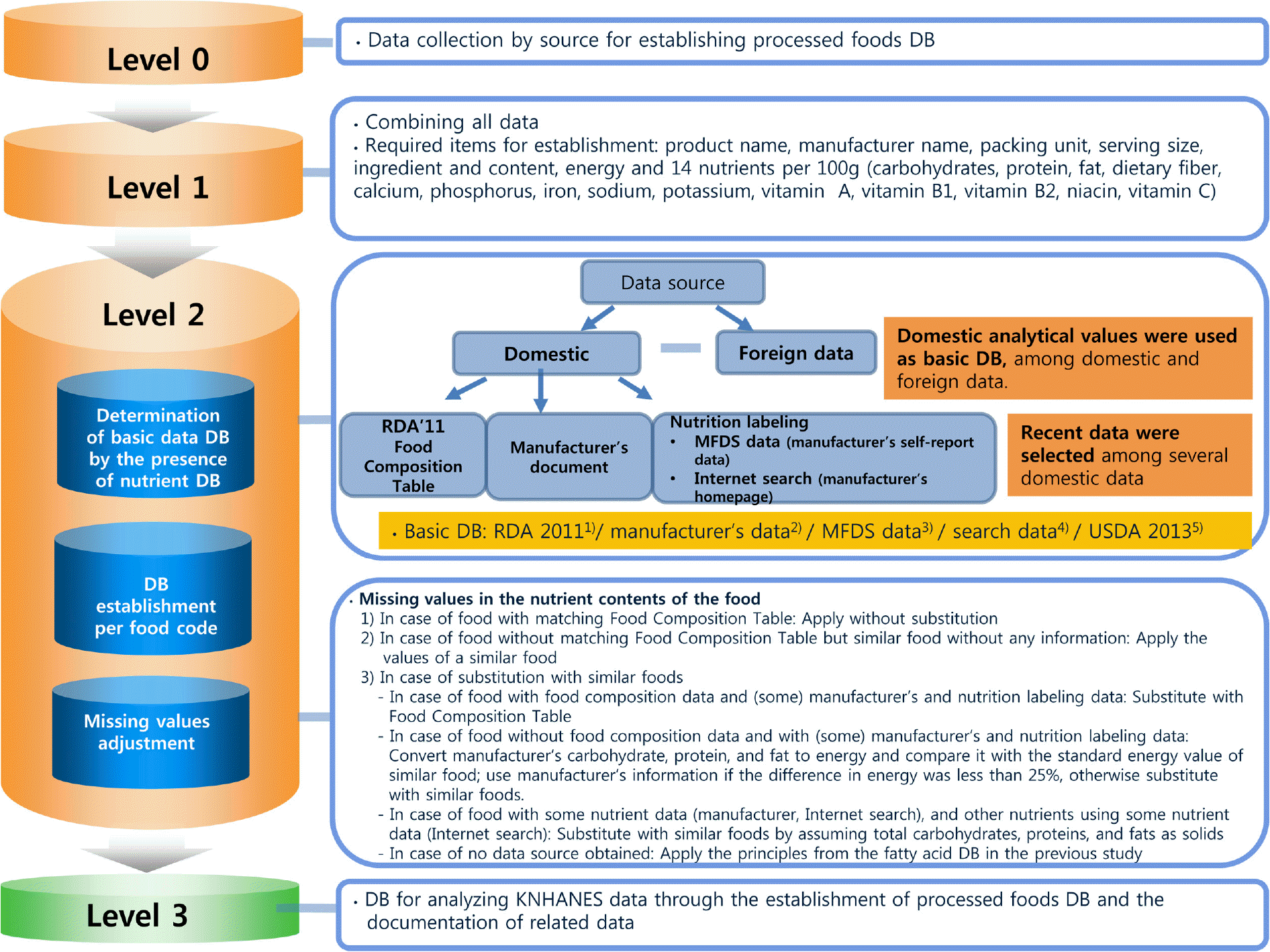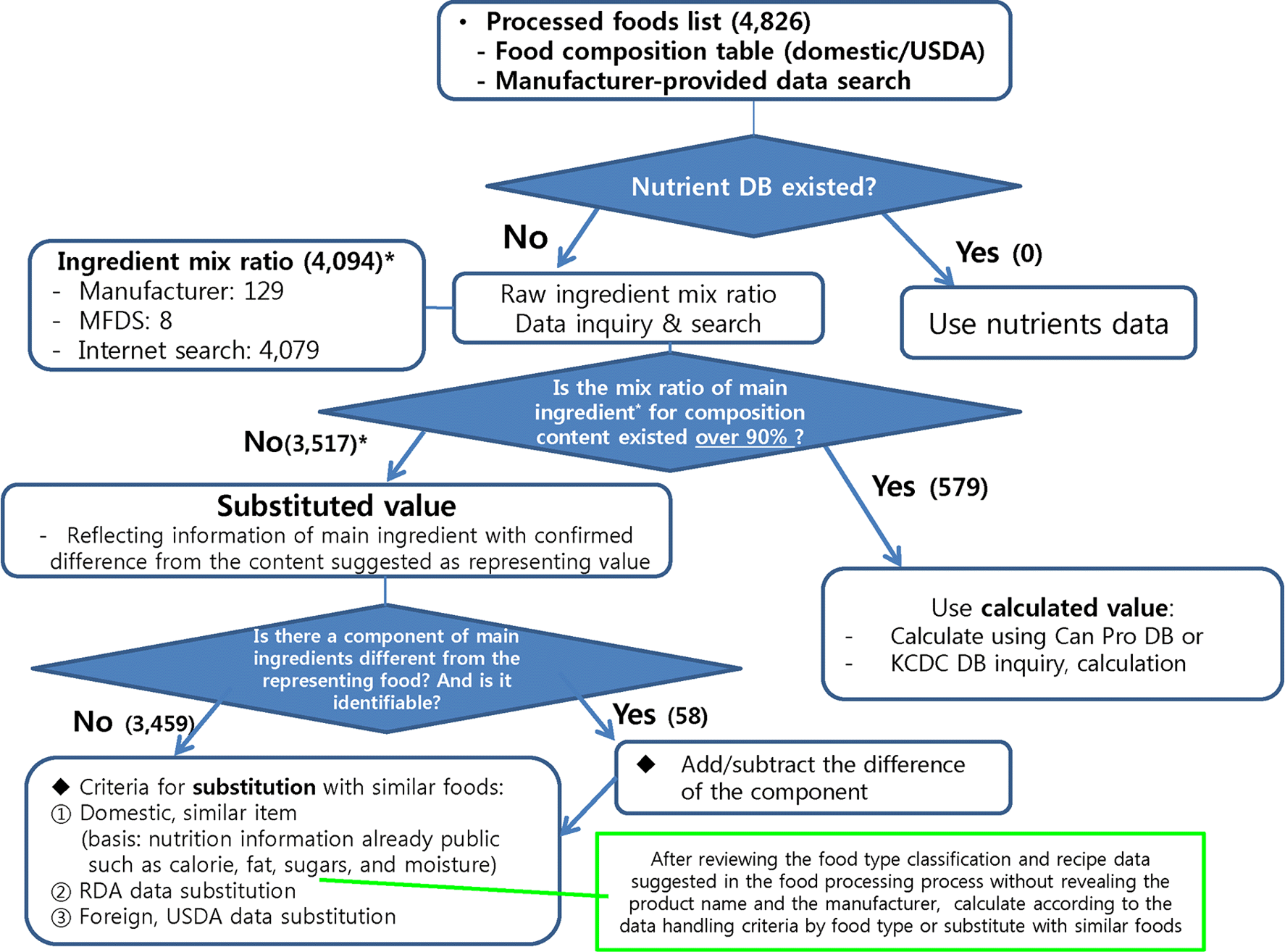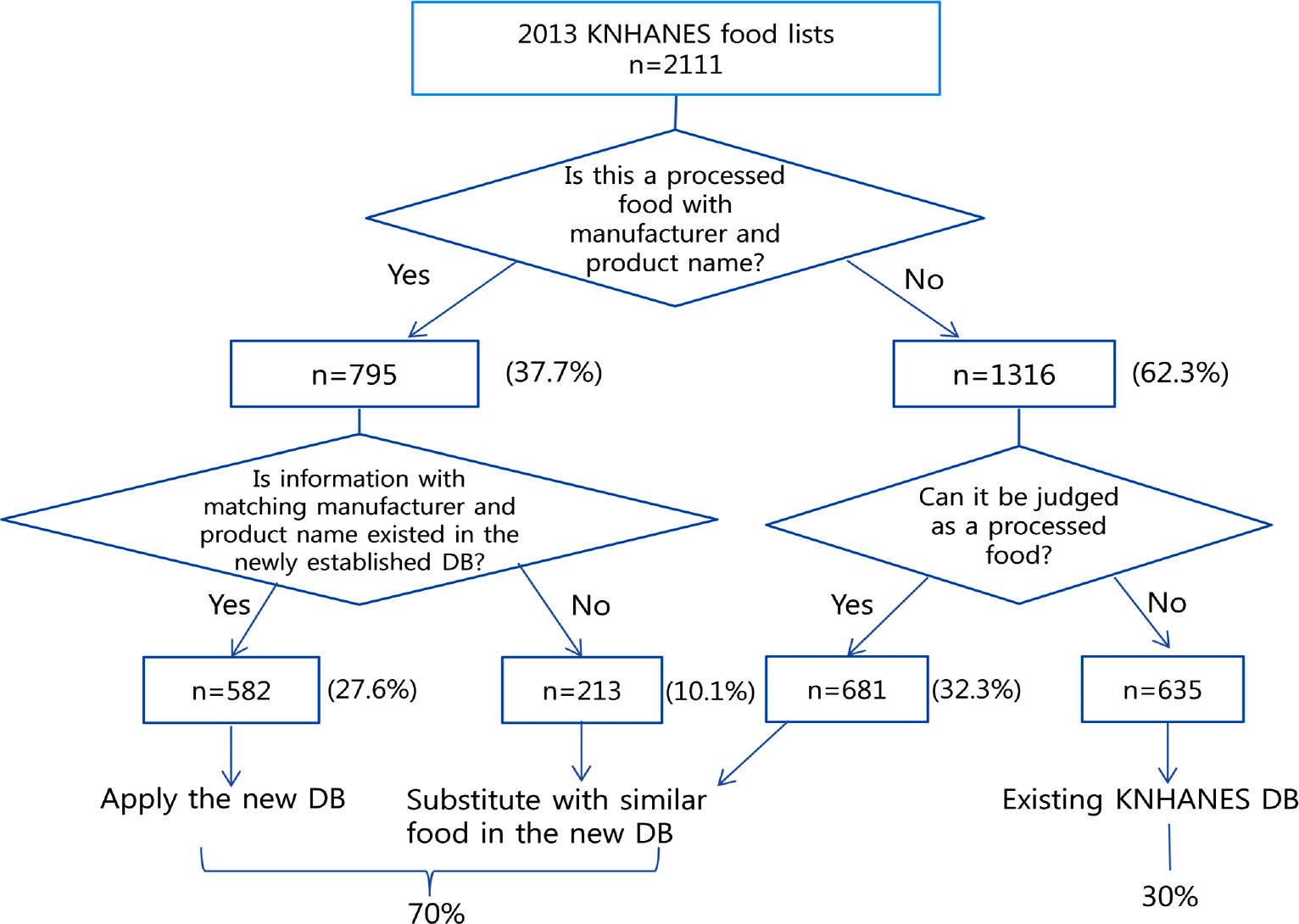1. Ford ES, Dietz WH. Trends in energy intake among adults in the United States: findings from NHANES. Am J Clin Nutr. 2013; 97(4):848–853.
2. Whitton C, Nicholson SK, Roberts C, Prynne CJ, Pot GK, Olson A, Fitt E, Cole D, Teucher B, Bates B, Henderson H, Pigott S, Deverill C, Swan G, Stephen AM. National diet and nutrition survey: UK food consumption and nutrient intakes from the first year of the rolling programme and comparisons with previous surveys. Br J Nutr. 2011; 106(12):1899–1914.

3. Ministry of Health and Welfare, Korea Centers for Disease Control and Prevention. Korea Health Statistics 2011: Korea National Health and Nutrition Examination Survey (KNHANES V-2). Cheongwon: Korea Centers for Disease Control and Prevention;2012.
4. Lim AH, Choi SY, Shim JE, Hwang JY, Moon HK, Kim K. Development of dietary behavior items available in Korea National Health and Nutrition Examination Survey. J Nutr Health. 2015; 48(5):407–418.

5. Sohn S. Factors related to the health related quality of life in elderly women. Korean J Women Health Nurs. 2009; 15(2):99–107.

6. Weaver CM, Dwyer J, Fulgoni VL 3rd, King JC, Leveille GA, MacDonald RS, Ordovas J, Schnakenberg D. Processed foods: contributions to nutrition. Am J Clin Nutr. 2014; 99(6):1525–1542.

7. The University of Auckland (NZ). NUTRITRACK: a processed foods database to promote the health of New Zealanders [Internet]. Auckland: The University of Auckland;2014. [cited 2016 Jan 19]. Available from:. http://www.foodandhealth.auckland.ac.nz/en/about/news/news-2014/2014/05/nutritrack.html.
8. Yun S, Kim HJ, Oh K. Trends in energy intake among Korean adults, 1998–2015: results from the Korea National Health and Nutrition Examination Survey. Nutr Res Pract. 2017; 11(2):147–154.

9. United States Development of Agriculture, Agricultural Research Service. National nutrient database for standard reference, release 25 [Internet]. Washington D.C.: United States Development of Agriculture;2013. [cited 2015 Aug 19]. Available from:. http://www.ars.usda.gov/Services/docs.htm?docid=23635. www.ars.usda.gov/Services/docs.htm?docid=23635.
10. Ministry of Education. Culture, Sports, Science, and Technology (JP). Standard tables of food composition in. Japan: fifth revised and enlarged edition. Tokyo: Ministry of Education, Culture, Sports, Science, and Technology; 2005. Sports, Science, and Technology;2005.
11. European Food Information Resource. Food composition database [Internet]. Brussels: European Food Information Resource;2017. [cited 2017 Mar 11]. Available from:. http://www.eurofir.org/food-information/food-composition-databases-2/.information/food-composition-databases-2/.
12. Health Canada. Food and nutrition [Internet]. Ottawa: Health Canada;2016. [cited 2016 Jun 3]. Available from:. https://www.canada.ca/en/health-canada/services/food-nutrition/healthy-eating/nutrient-data/canadian-nutrient-file-2015-download-files.html.
13. Kim SY, Kang MS, Kim SN, Kim JB, Cho YS, Park HJ, Kim JH. Food composition tables and national information network for food nutrition in Korea. Food Sci Ind. 2011; 44(1):);. 2–20.
14. Yoon MO, Kim K, Hwang JY, Lee HS, Son TY, Moon HK, Shim JE. Development of a fatty acids database using the Korea National Health and Nutrition Examination Survey data. J Nutr Health. 2014; 47(6):435–442.

15. Ministry of Agriculture, Food and Rural Affairs; Korea Agro-Fisheries & Food Trade Corporation. 2016 development of processed food standard system: 2nd. Naju: Korea Agro-Fisheries & Food Trade Corporation;2016.
16. Ministry of Food and Drug Safety (KR). Korean food standards codex. Cheongju: Ministry of Food and Drug Safety;2015.
17. Ministry of Health and Welfare, Korea Centers for Disease Control and Prevention. Korea Health Statistics 2014: Korea National Health and Nutrition Examination Survey (KNHANES VI-2) [Internet]. Cheongju: Korea Centers for Disease Control and Prevention;2015. [cited 2015 Aug 8]. Available from:. https://knhanes. cdc.go.kr/knhanes/sub04/sub04_03.do?classType=7.
18. Ministry of Food and Drug Safety (KR). Manufacturer's report data for processed food. Cheongju: Ministry of Food and Drug Safety;2015.
19. Korea Centers for Disease Control and Prevention. Ingredients ratio of prepared foods data. Cheongwon: Korea Centers for Disease Control and Prevention;2013.
20. Rural Development Administration (KR). Food composition table. 8th revision edition. Suwon: Rural Development Administration;2011.
21. The Korean Nutrition Society. Nutrient database of food [Internet]. Seoul: The Korean Nutrition Society;; [cited 2015 Aug 10]. Available from:. http://www.kns.or.kr/Center/FoodDB.asp.
22. Nongshim (KR). Nonshim brand [Internet]. Seoul: Nonshim;; [cited 2015 Jul 20]. Available from:. http://brand.nongshim.com/main/index.
23. Samyang Foods (KR). Samyang brand [Internet]. Seoul: Samyang Foods;; [cited 2015 Aug 20]. Available from:. http://www.samyang-food.co.kr/kor/brand/samyangRamen.do.
24. Maeil Dairies (KR). Maeil Dairies products [Internet]. Seoul: Maeil Dairies;[cited 2015 Sep 15]. Available from:. http://www.maeil.com/brand/list_brand1.jsp?cate_0.
25. Namyang Dairy Products (KR). Namyang Dairy Products brand [Internet]. Seoul: Namyang Dairy Products;; [cited 2015 Aug 10]. Available from:. http://company.namyangi.com/product/product. asp?cd=5. asp?cd=5.
26. Seoulmilk (KR). Seoulmilk product information [Internet]. Seoul: Seoulmilk;; [cited 2015 Jul 8]. Available from:. http://www.seoulmilk.co.kr/enterprise/product/product_list.sm.
27. Lotte Chilsung Beverage (KR). Lotte Chilsung Beverage brand [Internet]. Seoul: Lotte Chilsung Beverage;; [cited 2015 Aug 22]. Available from:. http://company.lottechilsung.co.kr/product/new_product.jsp?nPos=0301. product.jsp?nPos=0301.
28. Dongsuh Foods (KR). Dongsuh Foods products [Internet]. Seoul: Dongsuh Foods;; [cited 2015 Aug 10]. Available from:. https://www.dongsuh.co.kr/2017/02_products/02_product_list.asp. www.dongsuh.co.kr/2017/02_products/02_product_list.asp.
29. Crown (KR). Crown products [Internet]. Seoul: Crown;[cited 2015 Aug 10]. Available from:. http://www.crown.co.kr/product/pList.asp?catecode=1478063272.
30. Hai Tai Htb (KR). Hai Tai Htb products [Internet]. Seoul: Hai Tai Htb;; [cited 2015 Sep 20]. Available from:. http://www.htb.co.kr/Product_info/Product_info_13.jsp. Product_info/Product_info_13.jsp.
31. Sajo (KR). Sajo product Korea's representative brand [Internet]. Seoul: Sajo;[cited 2015 Aug 8]. Available from:. http://hp.sajo.co.kr/product/brand_list.asp.
32. Pulmuone (KR). Pulmuone products [Internet]. Seoul: Pulmuone;; [cited 2015 Aug 15]. Available from:. http://www.pulmuoneshop.co.kr/goods/displayList.do?headCateCd=005. co.kr/goods/displayList.do?headCateCd=005.
33. Home Plus (KR). Home Plus products [Internet]. Seoul: Home Plus;; [cited 2015 Jul 10]. Available from:. http://www.homeplus.co.kr/app.product.GoodDetail.ghs?comm=usr.detail&good_id=000048798&extends_id=naver&service_cd=56010.
34. Naver Storefarm (KR). Cn food products [Internet]. Seoul: Naver Storefarm;; [cited 2015 Aug 20]. Available from:. http://storefarmnaver.com/cnfood/products/320138360.
35. Interpark Shopping (KR). Processed Food products [Internet]. Seoul: Interpark Shopping;; [cited 2015 Aug 22]. Available from:. http://shopping.interpark.com/display/main.do?dispNo=. 001760&smid1=gnb&smid2=003&smid3=1.
36. Lottemart (KR). Lottemart products [Internet]. Seoul: Lottemart;; [cited 2015 Aug 22]. Available from:. http://www.lottemart.com/product/ProductDetail.do?CategoryID=C001001700010004&ProductCD=L000000002021&socialSeq=&koostYn=N.
37. Ahuja JK, Perloff BP. Quality control procedures for the USDA Food and Nutrient Database for Dietary Studies nutrient values. J Food Compost Anal. 2008; 21:S119–S124.






 PDF
PDF ePub
ePub Citation
Citation Print
Print




 XML Download
XML Download